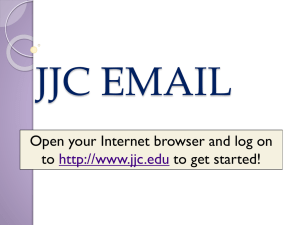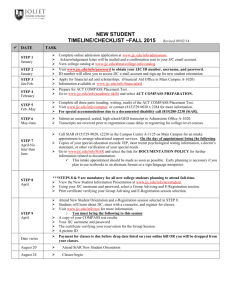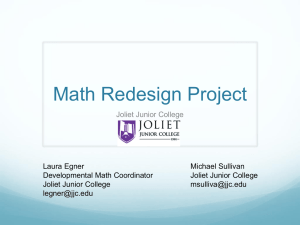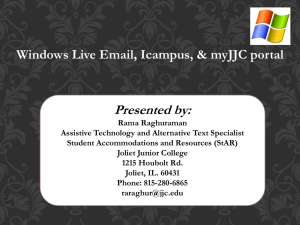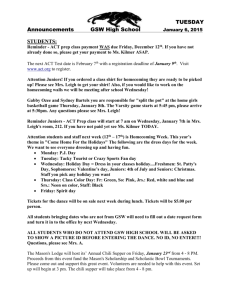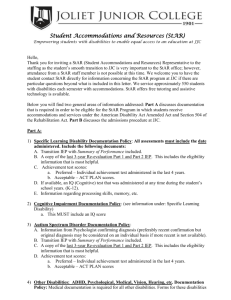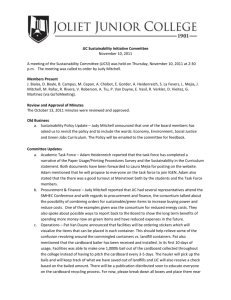SWOT Analysis Report FINAL
advertisement
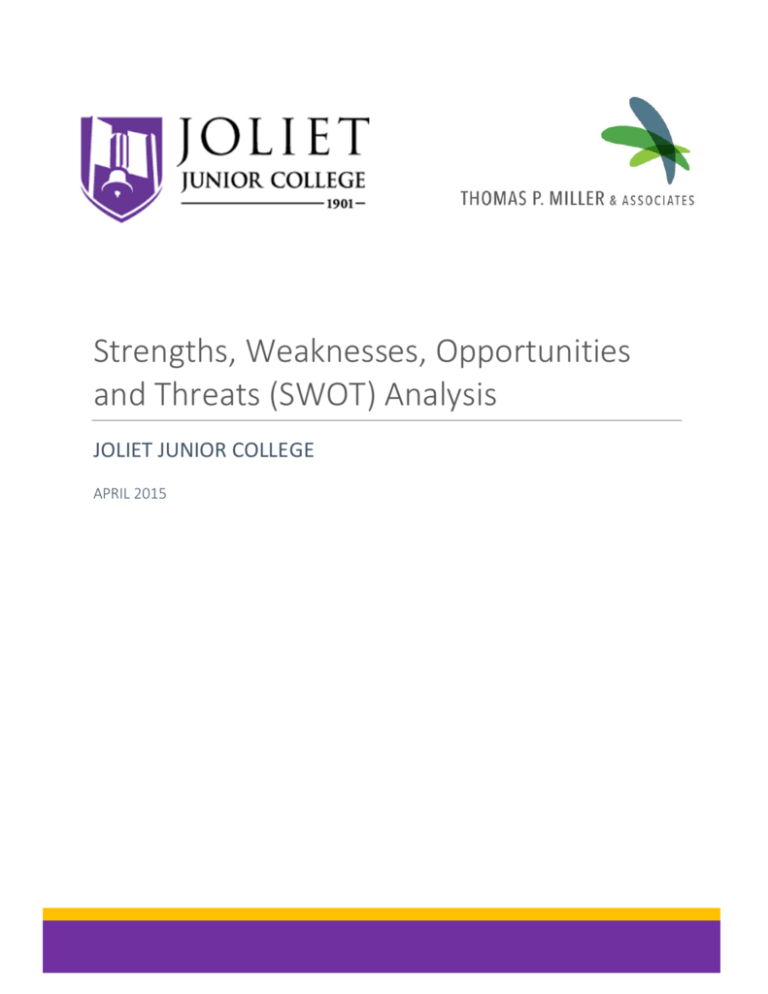
Strengths, Weaknesses, Opportunities and Threats (SWOT) Analysis JOLIET JUNIOR COLLEGE APRIL 2015 0|P a ge TABLE OF CONTENTS Introduction........................................................................................................................................................................... 2 Background................................................................................................................................................................... 2 Purpose ......................................................................................................................................................................... 2 Executive Summary ...................................................................................................................................................... 2 Regional Data Overview and Implications ........................................................................................................................... 3 Demographics............................................................................................................................................................... 3 Labor Market Trends.................................................................................................................................................... 4 Strengths Assessment ........................................................................................................................................................... 4 Rigorous Academic Programs ...................................................................................................................................... 4 Employee Commitment/Engagement ........................................................................................................................ 4 Physical Infrastructure ................................................................................................................................................. 4 Employer Support Foundation .................................................................................................................................... 5 Sustainability Initiatives/Practices............................................................................................................................... 5 Weaknesses Assessment ...................................................................................................................................................... 5 Data Availability, Integration and Alignment .............................................................................................................. 5 Communications and Marketing ................................................................................................................................. 5 Academic Counseling ................................................................................................................................................... 6 Business Process Confusion......................................................................................................................................... 6 Education Pathways Barriers and Transparency ........................................................................................................ 6 Opportunities Assessment.................................................................................................................................................... 6 Employer Engagement/Work-Based Learning ........................................................................................................... 6 Articulation Options/Partnering with Universities ..................................................................................................... 6 External Image Improvement ...................................................................................................................................... 7 Diversity of Entering Students ..................................................................................................................................... 7 Data-Informed Student Success .................................................................................................................................. 7 Threats Assessment .............................................................................................................................................................. 7 State Funding................................................................................................................................................................ 7 Federal Funding and Policy Uncertainty ..................................................................................................................... 7 Enrollment Levels ......................................................................................................................................................... 7 Perception of College ................................................................................................................................................... 8 Increased Higher Education Options........................................................................................................................... 8 Conclusion ............................................................................................................................................................................. 8 1|P a ge THOMAS P. MILLER AND ASSOCIATES, 2015 INTRODUCTION Background The Joliet Junior College Strategic Planning Committee and Thomas P. Miller and Associates (TPMA) Team have developed this Strengths, Weaknesses, Opportunities, and Threats (SWOT) Analysis report to organize and appropriately reflect data received through surveys, facilitated sessions, and quantitative sources for use in the Strategic Planning process. The purpose of the SWOT Analysis is to highlight emerging themes from the data gathering process that will serve as a focus for the development and implementation of goals and strategic priorities. The SWOT Analysis is a “high-level” look at where Joliet Junior College (JJC) can build on current successes and focus on implementing continuous improvement methods to correct current weaknesses or threats. Based on the information compiled in the SWOT Analysis, the JJC Strategic Planning Committee and the TPMA Team will then turn to drafting a Strategic Plan that will incorporate all of the data, feedback, and information gleaned to-date from data sources, as well as internal and external stakeholders. Purpose The purpose of the JJC SWOT Analysis is to identify both the internal and external factors that may impact JJC’s performance over the next three to five years. More specifically, this SWOT Analysis serves as a “bridge” between the data and feedback gathering process and the first draft of the Strategic Plan. By conducting a SWOT Analysis, the JJC Strategic Planning Committee and TPMA Team can validate both ‘what is working’ and ‘what is concerning’ for internal employees and external stakeholders. This, in turn, will lead to a Strategic Plan draft that incorporates the appropriate mission, vision, goals, and strategic priorities where specific organizational activities can be implemented that lead to improved performance and success in delivering a quality education to a diverse student body. Executive Summary Using the extensive employee, student, employer, and community feedback gathered, and after analyzing this data and both regional economic and demographic data, a concise understanding of JJC strengths, weaknesses, opportunities, and threats has emerged and is concisely displayed in the graphic below. Much overlap exists between the four quadrants, and many of the elements intertwine and should be seen as such, rather than standing alone. JJC’s strengths lie in the fact that it is meeting its core mission—strong academic programs—and has both physical and ‘people’ assets that serve as an important foundation from which to build. In particular, JJC has employees who are committed to the mission of JJC and want to further improvements that will increase organizational performance and student success. JJC’s weaknesses are primarily process driven issues that need attention. The importance of addressing these weaknesses needs to be underscored as improvements in organizational performance and employee morale/satisfaction can be realized. JJC’s opportunities are externally-centric elements that provide JJC with areas of focus that will build on current strengths and provide improved opportunities and options for students to progress through their academic experiences. JJC’s threats are externally-centric elements that must be understood and managed as JJC implements improvements, new initiatives and continuous improvement processes. 2|P a ge THOMAS P. MILLER AND ASSOCIATES, 2015 STRENGTHS WEAKNESSES RIGOROUS ACADEMIC PROGRAMS DATA AVAILABILITY, INTEGRATION AND ALIGNMENT EMPLOYEE COMMITMENT/ENGAGEMENT COMMUNICATIONS AND MARKETING PHYSICAL INFRASTRUCTURE ACADEMIC COUNSELING EMPLOYER SUPPORT FOUNDATION BUSINESS PROCESSES CONFUSION SUSTAINABILITY INITIATIVES/PRACTICES EDUCATION PATHWAYS BARRIERS AND TRANSPARENCY OPPORTUNITIES THREATS EMPLOYER ENGAGEMENT/WORKBASED LEARNING STATE FUNDING ARTICULATION OPTIONS/PARTNERING FEDERAL FUNDING AND POLICY UNCERTAINTY ENROLLMENT LEVELS PERCEPTION OF COLLEGE INCREASED HIGHER EDUCATION OPTIONS (PROPRIETARY COLLEGES) WITH UNIVERSITIES EXTERNAL IMAGE IMPROVEMENT DIVERSITY OF ENTERING STUDENTS DATA-INFORMED STUDENT SUCCESS REGIONAL DATA OVERVIEW AND IMPLICATIONS Demographics The overall population in the Joliet Junior College region (comprising of Will, Livingston, Grundy, Kendall, DuPage, La Salle, and Kankakee counties) is projected to increase three percent over the next five years. Within this population increase, the number of White Hispanics in the region, as well as individuals aged 25-34 years, are also expected to increase the most in the next five years. To account for these demographic changes in the region, JJC should take action to understand and plan for the educational needs of this non-traditional student age group and the growing Hispanic population, many of whom may have English as a Second Language. For instance, non-traditional adult students may require accelerated academic programming in order to engage or return to the workforce as quickly as possible. Demanddriven education is a great way to integrate hands-on and traditional classroom experience into an accelerated blended program for non-traditional students. See Opportunities section for more information on this type of education. 3|P a ge THOMAS P. MILLER AND ASSOCIATES, 2015 Associate’s degree attainment for the Joliet region is comparable to that of the rest of the nation (8%).1 This attainment rate is expected to increase by 3.2% over the next five years, suggesting that measurable recruitment and enrollment goals are needed to enroll the increasing number of area residents that will want to obtain a higher degree. In addition, Joliet Junior College will need to set measurable goals to increase area residents’ attainment of associate’s degrees to align with area need. Labor Market Trends Employment data from the JJC region shows that a number of industries will experience growth over the next five years including: Professional, Scientific, and Technical Services; Educational Services; Health Care and Social Assistance; and Transportation and Warehousing.2 JJC should focus on these industries the coming years in terms of program expansion and/or development. More specifically, the top occupations that will see the most growth over the next five years include: Personal Care Aides; Home Health Aides; Computer User Support Specialists; and Computer System Analysts.3 Therefore, IT and medical professions will see a need in the coming years, and could be a focus of JJC in program expansion and/or development. STRENGTHS ASSESSMENT Rigorous Academic Programs By all accounts, JJC has strong and rigorous academic programs that provide students with the knowledge, skills, and competencies needed to further their education through transfer or enter immediately into the workforce upon completion of the program. Student interviews and surveys demonstrate a high degree of confidence and satisfaction in their academic programs, as well as the faculty advising they receive concerning their academic options and pathways. Employers report that JJC students in a variety of fields are receiving the appropriate competencies and skills acquisition through their programs of study. JJC also has a variety of academic programming that meets both student and employer needs in a wide range of employment sectors and academic fields. Employee Commitment/Engagement Facilitated sessions and employee survey responses indicate a high level of employee engagement and interest in the success of the college and its students. While some frustrations and issues exist that should be addressed, for the most part, employees expressed concerns in a positive manner with an interest toward getting problems resolved. Overall, the most important element is a belief in the mission of JJC, and while the actual mission statement will be revised through the strategic planning process, employees expressed important core values and understanding of what the core mission of JJC involved and how the organization should function. Physical Infrastructure JJC has exceptional physical facilities, including 7 Leadership in Energy and Environmental Design (LEED) certified buildings and new buildings recently constructed or in the process of construction. While taking some years, a bond vote that passed favorably has allowed an expansion of facilities to meet student and employer demand. While many community colleges across the country face the problem of aged 1 EMSI Demographic Analysis, 2014 2 EMSI, 2-digit NAICS code 3 EMSI, 5-digit SOC code 4|P a ge THOMAS P. MILLER AND ASSOCIATES, 2015 infrastructure, lack of a tax local tax base or authority, or lack of space capacity, JJC is not faced with these challenges, which allows flexibility in developing or modifying academic and workforce programs. This is especially important if a program of study is equipment intensive. Employer Support Foundation JJC has a strong foundation of employer support in the community, and important relationships that allow for program enhancements and expansion. In particular, the College’s Corporate and Community Services department provides customized services to employers and is currently serving as a key “point of contact” that employers indicate they recognize and appreciate. Each academic department has advisory committees with employer representation, which is critical to ensuring that curriculum is connected to competencies and skills needed in the workforce. Sustainability Initiatives/Practices A source of pride and strength for JJC is its ongoing commitment to sustainability. These initiatives, which encompass economic, environmental and social equity principles, encompass a myriad of activities, projects and practices across the campus and in the community. Through a holistic approach which includes the entire college community, JJC has made sustainability a focused effort. JJC’s sustainability efforts are intended to improve the quality of the academic and social experience at JJC and help prepare students after leaving JJC. WEAKNESSES ASSESSMENT Data Availability, Integration and Alignment Many employees across various departments and divisions highlighted the extensive difficulty of both obtaining needed data and aligning data across the institution in order to operationalize performance and conduct continuous improvement. One comment at a facilitated session summarized the issue, “Everyone is keeping their own Excel spreadsheets and tracking their own data.” The problem rests with not only availability of data, but, more importantly, the strategic use of integrated data. Lack of strategic data integration and alignment is hindering individual and institutional efforts at utilizing a performance management framework that informs as to what service interventions improve the student experience and outcomes, as well as what efficiencies or improvements could be gained through changes to academic programs, student services or other functions at the College. This has severe consequences for JJC over time as both the federal government and Illinois move toward performance-based funding models and current and future employer and student consumers of JJC expect enhanced services and seek to make informed choices. Communications and Marketing Along with data availability, internal communications and external marketing were expressed by employees as two areas of weakness at JJC. Regarding internal communications, many symptoms of the problem exist, but recent turnover in administrative positions seems to have exacerbated the issue. Unfortunately, this communication gap is impacting trust as well, so rectifying the communication weakness is critical. While internal communications is a specific concern, external marketing was also a related, but specific concern as well. Many employees believe that strategic messaging about JJC is not occurring, including providing transparent academic pathways and program opportunities for prospective students. External 5|P a ge THOMAS P. MILLER AND ASSOCIATES, 2015 stakeholders were not always clear about both opportunities to engage and partner with the College or what is happening with the College. The external “Perception of the College” threat may continue to be a lingering and growing problem if external marketing weaknesses are not addressed. Academic Counseling Student facilitated sessions and surveys have identified academic counseling as a particular weakness of the College. A common refrain from students was that the “advising” they receive from faculty and faculty advisors is very helpful and what they have come to rely on, but that JJC’s general academic counseling is too general and too confusing. The biggest problem facing academic counseling is that students currently do not see it as a value-added experience. Business Process Confusion JJC has many different business processes and many different committees addressing many different issues. This has led to general confusion, and when combined with the communications gap, a great deal of speculation and ‘guessing’ about what is happening at JJC. Institutionalization of solid business practices is lacking in some cases, and processes are often paper-driven rather than automated. New employees are given little training on the business processes in place at the college, which may delay employee productivity. In addition, due to so many business process activities, employees tend to believe the college is process-driven rather than performance-driven. Education Pathways Barriers and Transparency Both students and external stakeholders in business and the community expressed a lack of understanding concerning JJC’s education pathways—how secondary programs align with JJC’s postsecondary programs align to jobs and industries in the region. This lack of transparency has many implications including impacts on enrollment, student ‘efficiency’ in completing an academic program and lack of full employer engagement. Barriers in education pathways such as current developmental education practices may be impacting persistence and student enrollment. Education barriers and transparency impact JJC’s ability to fully realize important outcomes that may be critical to future funding and resources opportunities. OPPORTUNITIES ASSESSMENT Employer Engagement/Work-Based Learning While JJC has a strong base of employer relationships, strategic engagement practices implemented at JJC would expand JJC’s reach to the employer community. This includes strategically participating in employer relocation opportunities with economic development. One internal practice could be the use of an ‘account manager’ concept where certain individuals in the College work together to develop which employers to reach out to, what the “ask” is, and what success looks like. Students expressed a desire for more work-based learning opportunities such as internships. Given that today’s work opportunities are largely contingent on networking and relationships, this student view is critically important. Articulation Options/Partnering with Universities JJC has a number of articulation options for students to transfer to continue their education, but this foundation could be expanded. Articulation of both general education credits and specialized programs is important and marketing those options so students can see how they can progress in their educational goals may attract more students. Further, JJC employees expressed an overall need to develop more 6|P a ge THOMAS P. MILLER AND ASSOCIATES, 2015 innovative partnerships with universities focused on practices that lead to increased student persistence and more developed educational pathways. External Image Improvement JJC experiences what a number of community colleges currently experience, or employees perceive is happening—a lack of awareness of what a ‘JJC education’ really means. While data still needs to be collected regarding what the external image of JJC is among high school students, adult learners, and others, both internal employees and external partners expressed that JJC’s programs and services could be better known and understood throughout the community. JJC also might be able to make better use of various marketing channels such as social media to provide a broader reach. Diversity of Entering Students JJC is a diverse student body that is only going to become increasingly so over the next 5-10 years. In particular, data show that JJC has opportunities to reach out and serve more students looking for employment opportunities in the late 20’s to early 30’s age demographic. In addition to age diversity, JJC has opportunities to serve a more racially and ethnically diverse student body, who may need various individualized services. JJC should also remain aware that, increasingly, female students are the majority of entering students at colleges and that programs which engage young men may be an area of innovation in serving a diverse student body. Data-Informed Student Success While JJC needs to focus on its data availability and business processes, the data itself is available, and packaging it in such a way that allows for individualized student success is a large opportunity. For purposes of this exercise, student success is determined by the student himself/herself, so innovation in how JJC packages and displays data for students to make informed choices and work with advisors and faculty is a major opportunity and area of focus. THREATS ASSESSMENT State Funding The State of Illinois is facing major reductions in state outlays due to budget deficits, including a current $1.6 billion deficit4 in the current state fiscal year. JJC must anticipate further reductions to state funding, necessitating the implementation of strategies to diversify its funding portfolio. Federal Funding and Policy Uncertainty The federal government is moving toward more performance-based funding and evidence-based practices in workforce and higher education programs. Also, given disagreements on larger issues such as the federal budget and policy, continued uncertainty in Washington, DC may lead to continued unpredictability when managing JJC. Enrollment Levels With the economy improving somewhat from the depths of the 2009-2010 recession, JJC’s enrollment is declining, which impacts revenue and programs. Developing both modifications to enrollment declines 4 http://www.reuters.com/article/2015/03/26/usa-illinois-budget-idUSL2N0WS27920150326 7|P a ge THOMAS P. MILLER AND ASSOCIATES, 2015 while simultaneously proactively recruiting new students to counteract declining enrollments is a threat focus. Perception of College An ongoing perception in the community that JJC does not provide a ‘quality’ education or it is where non-performing students attend is a threat that can impact enrollment, new partnerships, and revenue. Increased Higher Education Options JJC is faced with increasing competition from many universities and colleges, specifically from the proprietary sector. Many of these proprietary schools have focused resources (including it is “everyone’s job”) dedicated to marketing, outreach and enrollment of students and provide easy avenues for accessing programs, including assistance with obtaining financial aid. CONCLUSION The Strengths, Weaknesses, Opportunities, and Threats (SWOT) Analysis reveals that deliberate changes must be made to facilitate institutional growth and development and meet the expectations of employer and student customers. As outlined above, Joliet Junior College has the foundation necessary to offer an individualized and innovative educational experience, but focused changes will be required for expansion and growth and meeting institutional priorities. An important note: while finite resources are always a factor in addressing weaknesses or threats, it should not be assumed that the reason for the weakness or threat is due to finite resources. Organizations make resource allocation decisions continuously, and prioritize how and whether to address certain strategic priorities. Additionally, all organizations have a certain level of “costs” due to inefficient or unnecessary processes, redundancy, and/or bureaucracy that could be identified, eliminated and reprioritized. In addressing strategic priorities, it will be important for JJC to address the core issues and not just assume it is a resource problem. Finally, this SWOT Analysis provides a nice baseline of the feedback received by employees and external stakeholders that concisely targets issues to address in the JJC Strategic Plan and operationalizing of that Plan. Ultimately, by recognizing strengths and weaknesses, and factoring opportunities and threats into concrete actions through the strategic planning process will help position JJC as a quality and prominent educational institution in the community and state. 8|P a ge
